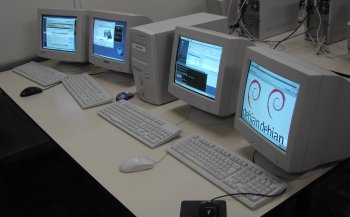Multi-user computer
A multi-user computer or a multi- terminal configuration is a single computer on which several users can work at the same time. The configuration usually consists of a monitor, a keyboard and a mouse for each individual user, which are all connected to a single computer.
commitment
The first multi-user systems were developed back in the 1970s . With the increasing computing power of the processors and sufficient main memory size, a large number of programs can be processed simultaneously in a computer without overloading the computer. However, with the standard configuration, only one user is able to use the computer; the system is usually not fully utilized and the computer remains idle most of the time. With a multi- user computer / multi-terminal , several users can share a powerful computer and thus save costs.
conditions
For a multi-user computer, a screen , keyboard and mouse must be provided for each user . If normal graphics cards are used, you also need a separate one for each workstation. However, there are also graphics cards specially designed for such systems, which can then supply several monitors at the same time.
Multi-user computer under Linux
In an operating system such as Linux, user interaction is enabled through the X Window System . There are a number of ways in which a multi-user computer / multi-terminal can be implemented under Linux:
- iTALC
- OS multiseat
- MultiSeat Linux 2011
- Ruby (using a kernel - patches )
- evdev (a protocol)
- faketty (a kernel module)
- Xnest (a nested multiterminal)
- Xephyr (a nested multiterminal)
- framebuffer driver in the kernel (a kernel module)
Multi-user computer under Windows
- A multi-user configuration can be implemented under the Windows operating system from Windows 2000 . However, this is currently only possible with commercial software. For example, TwinPac from Schwarz Computer Systeme, like BeTwin from ThinSoft, enables a PC with Windows 2000 or XP to be equipped with up to four workstations. For Windows 7 there is now the commercial software SoftXpand from MiniFrame, which allows a PC to be equipped with up to 16 workstations.
See also
- Multi-Head (multi-screen computer)
literature
- c't article 10/2006, pages 228 to 235: Multiseat Linux (practice)
- c't -Article 05/2013, pages 158 to 160: More space (providing several Ubuntu workstations with one computer)
